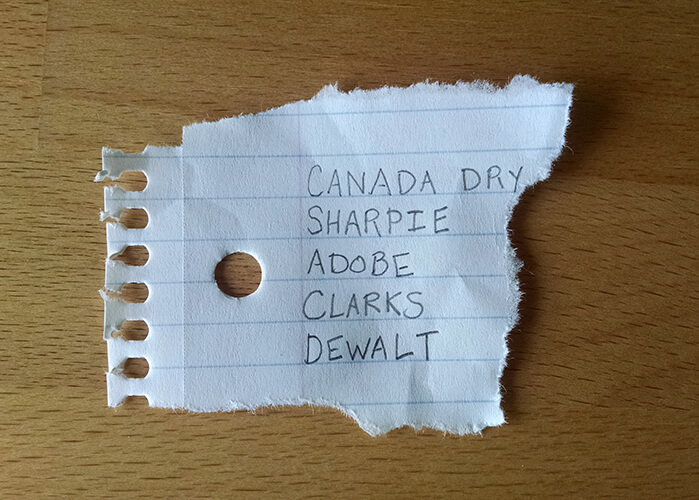Brandcrumbs: Why Brand Naming Fails
(This brand naming post is part of an ongoing series of posts we’re calling Brandcrumbs, which are bits and pieces of branding advice left over from our regular conversations about real-world brand positioning challenges.)
Brand naming is one of my favorite things to do at MarketPlace. I love the process of moving alphanumeric characters from concept to trademark; I love developing a well-positioned name that’s not a same-old-portmanteau or too-clever-by-half neologism; and I love conquering the beasts of semantic (morphemic, and even phonemic!) connotation and irrational association. What I don’t love and what is arguably the greatest challenge in brand naming: setting expectations for how a name should feel.
I take that back. The greatest challenge in brand naming is setting expectations for how a name shouldn’t feel.
Don’t Settle for “Sounds-Right”
We’ve developed around 30 brand names over the course of the last two years, from food ingredients to processing technologies to development platforms to consumer packaged goods to nutrition brands. And in many instances, we’ve addressed this challenge, which I call the Sounds-Right Trap.
I often explain the Sounds-Right Trap using the example of a grown child (human or pet). For many of us, when we think of our children’s names, we think “that’s just his name” or “I can’t imagine her having any other name” or “no other name would sound right.”

And that certainty about the way a name sounds is completely legitimate. However, this Sounds-Right certainty we have about their names is a retrospective certainty. This Sounds-Right certainty is the culmination of years of brand awareness, brand encounter, brand experience, and brand layering. In other words, most of us didn’t feel this sense of “this is exactly right and there could be no other name” when we first gave our children their names. We likely had good reasons for selecting those names (among them family tradition, sibling alliteration, honoring our heroes), just as we have good reasons for selecting brand names. But we didn’t have this Sounds-Right certainty during the naming process.
The Sounds-Right Trap is another way of talking about brand equity. In terms of naming as a brand discipline, we expend a lot of time on positioning, viability, and testing. However we do so knowing that, ultimately,
and that, together, will work to give us the Sounds-Right certainty, the sense that the name feels or sounds right.
The Power of Brand Equity
Try as hard as you can to imagine some of your favorite brand names as words only, as isolated strings of letters on a sheet of paper in the brand name development process.
Now stop trying—it’s impossible. Brand equity is too powerful to dismiss, and that’s the point. Brand equity is what gives a brand name its fundamental power, what makes it sound right.
I wish I could have been around when some of the most successful brands were in the brand name development phase. This is how I imagine some of them.
Fictional Brand Name Development Monologue
- Amazon naming meeting: “I mean, yeah, that’s a really big river and everyone knows that it’s a river that carries things from one end of a continent to another. But it just doesn’t have that wow factor, you know?”
- Nike office (some time around 1970): “You know, ‘Nike,’ the Greek goddess of victory. You know that, right?” “I had no clue. I mean, it’s nice to say, so there’s that. I’m just not sure if it feels right. But you know what? In the future, everyone will be smarter, so I’m sure every consumer will know the Greek mythology origin of the word, so let’s just do it.”
- Xfinity headquarters: “How about the word infinity, but cooler? Feels rad, right?”
- Meeting between publicity director Stewart Widdess and founder John Geisse: “We need to differentiate our upscale discount store from the department store, so I’m thinking ‘Target.’” “That’s it? Just the generic word ‘target’? It’s so . . . so . . . like you just picked a common noun out of the dictionary. It doesn’t hit me. No wow factor. Not sure that’s gonna work.”
- Peter Thiel’s diary: “Something honest and friendly and approachable. Maybe ‘CashGuardian’ or ‘BankChum’ or, ooooooohhhh . . . ‘PayPal.’”
- Pizza Hut meeting: “How about ‘Pizza House’? Or ‘Pizza Diner’? They’ve tested really well.” “I know, but we have room for only 9 characters on the sign.” “Welp, ‘Pizza Hut’ it is.”
Develop a Solid Brand Naming Strategy
I realize that there’s a difference between a name for a nutraceutical ingredient technology and a lifestyle brand name. If anything, we’re more likely to expect that moment of Sounds-Right certainty for consumer brands than B2B brands. However, we continue to wrongly demand it of even them; how much less should we demand it of a name for a “processing technology.” I don’t mean to discount intuition and gut feeling, but I also hate to see and experience the Sounds-Right Trap derail solid naming strategies and processes.
I’ve only touched the surface (“Ooh, let’s call our new computer the ‘surface.'” “People put things on surfaces, not create things on them; that’s no name for a Microsoft product.”) here, and there’s a lot more to say about brand naming. If nothing else, we hope that if you have a brand naming project, you’ll stay alert for the Sounds-Right Trap. If you need backup, we’d love to help, so do give us a call or take a look at our approach to brand naming.
Learn more about our focus on and approach to food industry brand strategy and development. To read more posts like this on food industry marketing issues and trends, visit our Insights page.


